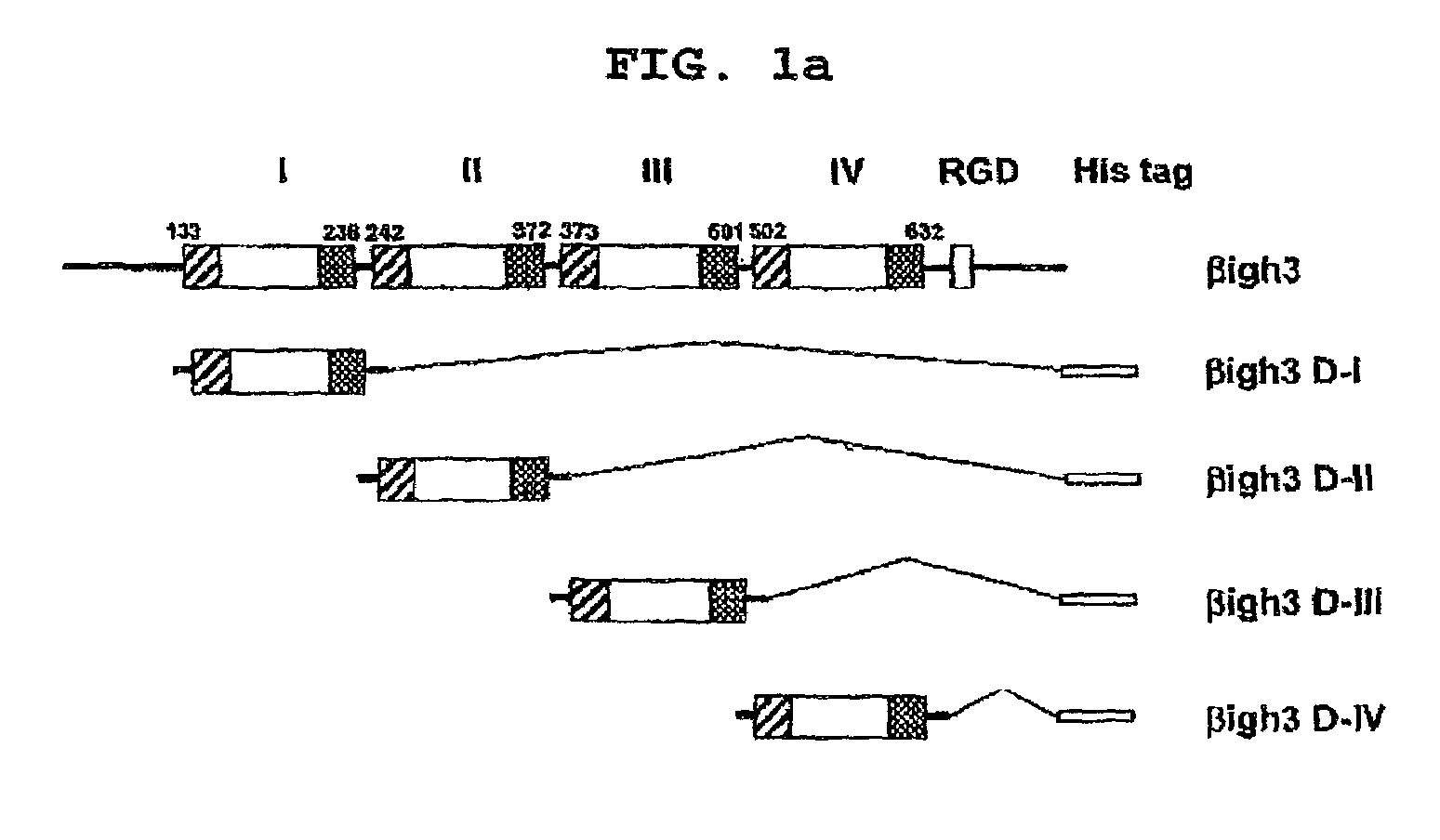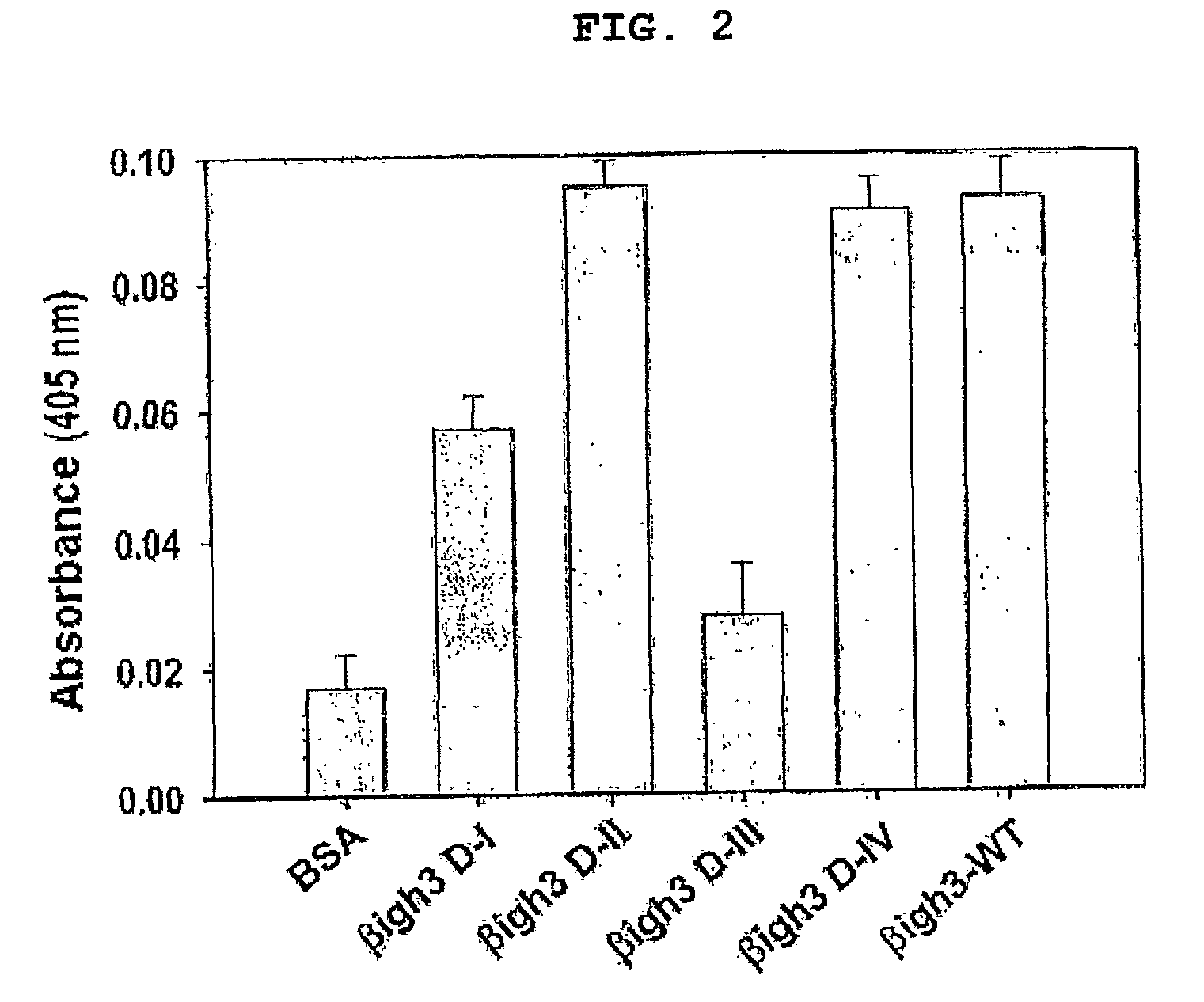Peptides and derivatives thereof showing cell attachment, spreading and detachment activity
a technology of peptides and derivatives, which is applied in the direction of peptide sources, peptide/protein ingredients, drug compositions, etc., can solve the problem that conserved peptides are not effective for ig-h3-mediated cell attachmen
- Summary
- Abstract
- Description
- Claims
- Application Information
AI Technical Summary
Benefits of technology
Problems solved by technology
Method used
Image
Examples
example 1
Generation of Recombinant βig-h3 Fas-1 Domain Proteins and Assay for Cell Attachment Activity
[0046]To find the amino acids essential to the cell adhesion of βig-h3, the ability of each of the four repeat fas-1 domains to mediate the cell adhesion of βig-h3 was examined. To this end, four recombinant proteins that contained the four repeat fas-1 domains respectively were generated for cell attachment activity assay.
1-1 Production of Recombinant βig-h3 fas-1 Proteins Encoding Each of Four Repeat Domains
[0047]Four DNA fragments encoding the 1st to 4th domains corresponding to the amino acid residues 133 to 236, 242 to 372, 373 to 501, and 501 to 632 of the human βig-h3 protein, respectively, were generated by PCR and cloned into pET-29β(Novagen) to construct expression vectors for fas-1 domains, named βig-h3 D-1, βig-h3 D-II, βig-h3 D-III, and βig-h3 D-IV, as shown in FIG. 1a. 6 tandem repeated histidine residues were provided to the C-termini of the DNA fragments to make a His-tag, wh...
example 2
Amino Acids, Aspartic Acid and Isoleucine, Essential to the Cell Attachment and Spreading Activity of βig-h3
2-1: Amino Acid Sequence Alignment of Various Proteins Containing fas-1 Domains
[0055]To identify amino acids responsible for cell adhesion from 2nd and 4th fas-1 domains of βig-h3, each having cell attachment and spreading activity, not only the internal repeat fas-1 domains of βig-h3, but also other proteins containing fas-1 domains were subjected to amino acid sequence alignment. As a result, two amino acids, that is, aspartic acid and isoleucine were found to be highly conserved at the site near the H2 region of each fas-1 domain among various substrate proteins, as shown in FIG. 4. On the whole, both aspartic acid and isoleucine are conserved in various fas-1 domains, including the 2nd and 4th fas-1 domains of βig-h3, while only aspartic acid is conserved in the 1st fas-1 domain. As for the 3rd fas-1 domain, it has neither of the two amino acids.
2-2: Generation of Recombin...
example 3
βig-h3-Mediated Synthetic Peptides with Cell Attachment, Spreading and Detachment Activity
[0061]With the confirmation of the indispensability of aspartic acid and isoleucine for the cell attachment activity, peptides containing the two amino acids were synthesized and assayed for cell attachment and detachment activity.
3-1: Synthesis of βig-h3 fas-1 Domain-derived Proteins
[0062]Peptides derived from the 1st, 2nd and 4th fas-1 domains of βig-h3 and a control peptide were synthesized with the aid of an automated multiple peptide synthesizer (PE / ABD 433) by standard solid phase procedures and they were isolated and purified by reverse phase high performance liquid chromatography. The synthesized peptides were designed to have KADHH (a.a 219–223) of SEQ. ID. NO. 1, NKDIL (a.a. 354–358) of SEQ. ID. NO. 2, and EPDIM (a.a. 615–619) of SEQ. ID. NO. 3, corresponding to conserved sequences of the 1st, 2nd and 4th fas-1 domains of βig-h3, respectively, and the control peptide DEMPI had the sam...
PUM
| Property | Measurement | Unit |
|---|---|---|
| pH | aaaaa | aaaaa |
| pH | aaaaa | aaaaa |
| pH | aaaaa | aaaaa |
Abstract
Description
Claims
Application Information
 Login to View More
Login to View More - R&D
- Intellectual Property
- Life Sciences
- Materials
- Tech Scout
- Unparalleled Data Quality
- Higher Quality Content
- 60% Fewer Hallucinations
Browse by: Latest US Patents, China's latest patents, Technical Efficacy Thesaurus, Application Domain, Technology Topic, Popular Technical Reports.
© 2025 PatSnap. All rights reserved.Legal|Privacy policy|Modern Slavery Act Transparency Statement|Sitemap|About US| Contact US: help@patsnap.com



